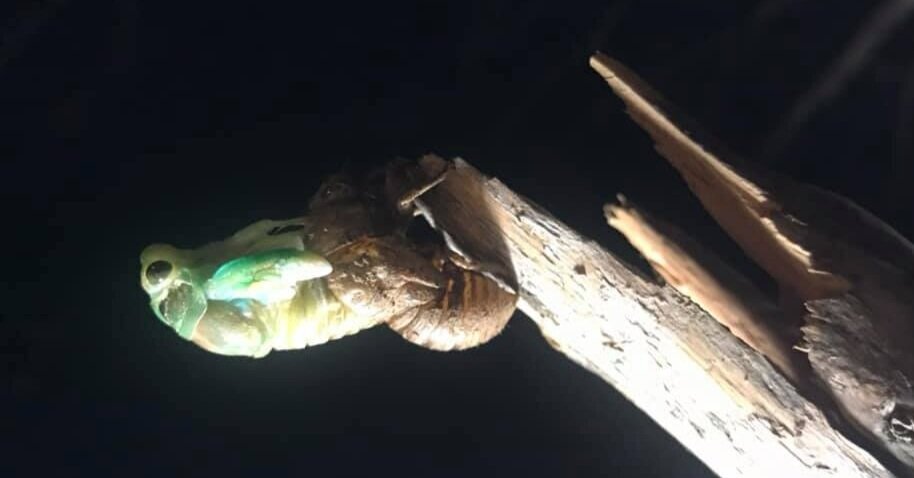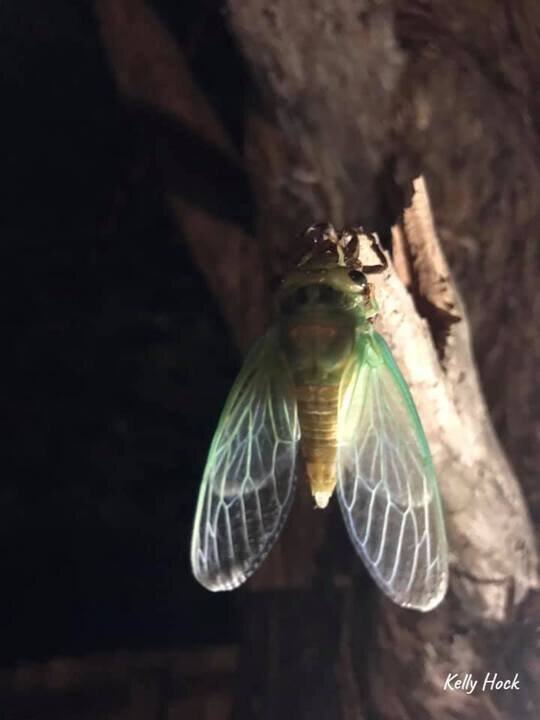Meet The Cicada By Kelly Hock
Not all people are bug people, but I have found that sometimes a little information can go a long way toward stemming fear, so let me introduce you to the harmless and annual Scissor-Grinder Cicada.
The Scissor -Grinder Cicadas are the bulging-eyed, shell-leaving creatures that crawl out of the ground and buzz around like giant, hyper, intoxicated bugs on a mission, quickly flying into things during the dog days of summer here in Missouri. Cicadas are often seen being devoured by ants on a sidewalk or being chased and swatted at by cats and dogs like a new play toy, until they become a treat.
Named for their song sounding like scissors being sharpened on an old-time grinding wheel, the Scissor Grinder Cicada in Missouri, Neotibicen pruinosus, is an "annual" cicada. Their life cycle begins with the females laying eggs in small branches on trees and woody plants. Once they hatch, the nymphs drop to the ground and burrow down to reach a root, suck sap, and grow and molt several times. Eventually, they use their feet designed for digging and clinging to make their way back up to the surface. From there the fully developed nymphs take an epic journey to find a place to exit and leave their shell. You can find tiny ½ inch holes in the ground around trees where you see their shells or exuviae. Once a spot has been selected, the cicada begins its transformation by pushing out its head, then thorax, elegantly leaning backward and bending upside down like Cirque Du Solei contortionists. At the last moment they are hanging so far out that it appears they will assuredly fall to their doom. Then the cicadas gracefully and extremely slowly reach forward, grabbing the head of the shell from which they are emerging, and gently release the rest of their body. The cicadas hang on to the heads of their exuviae; bodies stretched out, their wings slowly unfolding in such silent, minuscule amounts it is almost imperceptible. Once their wings are entirely revealed, they go through their final steps of transformation. The cicada goes through unsuspected and beautiful hues of gold on the way; their bodies and wings change colors and harden, becoming the adult Scissor-Grinder. These are reminiscent to what we have come to see all these summers. Once a fully transformed adult, the scissor grinder only lives 4-5 weeks.
The scissor -grinding buzz we hear is the mating call of the male, who emerges first. He makes his call, which can individually be as loud as a lawnmower, by expanding and contracting his tymbal near the wings on the sides of his abdomen. The female, who emerges a few days later, responds by clicking its wings together to alert males to her location. She will only mate once, so she may not accept her first suitor. You can imitate the female’s clicking response by snapping your fingers at a slow yet steady pace but be aware; it calls a male cicada which might land on you. (If interested, one can easily watch video examples with a quick internet search) After mating, the female begins her hunt for the perfect sized branch of a quarter to half an inch diameter, to hide her eggs. She will make several tiny slits and lay her eggs 20-40 at a time, laying a total of 200-400 eggs. Once fully transformed from a nymph, the adult scissor-grinders only live 4-5 weeks.
Ten Myths, Facts, & Benefits of Cicadas
1. Cicadas are not locusts. Locusts are the things of biblical plagues, a type of grasshopper devouring plants and leaves. Cicadas suck the sap and are incapable of chewing and devouring anything. Cicadas aren’t primarily beneficial.
2. Cicadas do not attack anything and do not bite. Not only do they not bite, they cannot bite. They don't have chewing/chomping mouthparts. They are designed to suck sap and could not bite you if they wanted to. If they fly into you, I promise it was not an intentional attack. Everything seems to eat these bugs, and it just desires evasion; sometimes it isn't very good at it.
3. Pretty much everything that can eat a cicada eats cicadas. That includes people around the world. Cicadas have as much protein as red meat. They contain all nine amino acids, making them a complete protein and an excellent source of antioxidants.
4. Although saplings or small woody plants made up of primarily small branches can suffer irreparable damage due to the females' egg-laying, Cicadas do not harm adult established trees. Cicada nymphs feed on the sap in the roots, which takes some of the nutrients, but this has not been known to damage trees. Cicadas can also benefit established trees by aerating the ground, pruning the small branches, and their dead bodies give nitrogen back to the soil.
5. Most all other insects that leave an exuvia, eat it. Cicadas don't because they don't have the mouthparts.
6. The exuviae of cicadas have been used in traditional medicines throughout history for ailments such as migraines, inflammation, cancer, convulsions, and more, but WARNING it is known to be dangerous for pregnant women.
7. You can tell females and males apart by their abdomen. The females' abdomens come to a pronounced dark point, and males are more domed: think “shield bug”.
8. There are over 3,000 types of cicadas—Periodicals that emerge in 7,13, and 17-year intervals and Annuals, which is a misnomer, that emerge every 2-5 years with overlapping generations.
9. All cicadas have the same life cycle. They only vary in how long they stay underground. Some ponder if the 13 and 17-year cicadas may emerge during prime years to avoid predators' cycles and avoid becoming prey for other animals.
10. The fluctuating seasons are believed to be affecting the emergence time of some cicadas as some broods are emerging early.
*Photos courtesy of Kelly Hock and MDC







